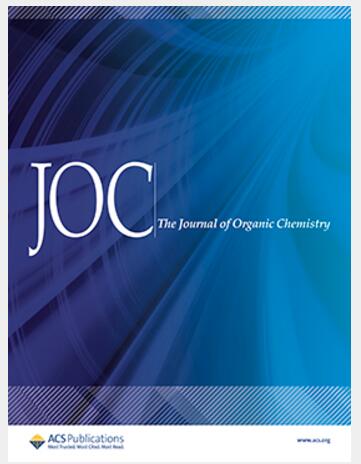tempo介导的1,4-醌的直接C(sp2) -H烷氧基化/芳基化
IF 3.6
2区 化学
Q1 CHEMISTRY, ORGANIC
引用次数: 0
摘要
在简单温和的条件下,在 TEMPO 的存在下,通过与易得的醇和酚直接发生交叉脱氢偶联,开发出了一种便捷高效的无过渡金属方法,用于 1,4-quinones 的 C(sp2)-H 烷氧基化/芳氧基化。该方法可安装多种烷氧基/芳氧基基团,对官能团的耐受性高,底物范围广,可在简单的一锅操作中获得良好甚至极佳的产率,并可在克级规模上进行。机理研究表明,该方法涉及自由基途径。本文章由计算机程序翻译,如有差异,请以英文原文为准。

TEMPO-Mediated Direct C(sp2)–H Alkoxylation/Aryloxylation of 1,4-Quinones
A convenient and efficient transition-metal-free method has been developed for the C(sp2)–H alkoxylation/aryloxylation of 1,4-quinones by direct cross-dehydrogenative coupling with readily available alcohols and phenols in the presence of TEMPO under simple and mild conditions. The method allowed the installation of a wide range of alkoxy/aryloxy groups, exhibited high functional group tolerance, showed a broad substrate scope, afforded good to excellent yields of products in a simple one-pot operation, and could be performed on a gram scale. Mechanistic investigation indicated the involvement of the radical pathway.
求助全文
通过发布文献求助,成功后即可免费获取论文全文。
去求助
来源期刊

Journal of Organic Chemistry
化学-有机化学
CiteScore
6.20
自引率
11.10%
发文量
1467
审稿时长
2 months
期刊介绍:
Journal of Organic Chemistry welcomes original contributions of fundamental research in all branches of the theory and practice of organic chemistry. In selecting manuscripts for publication, the editors place emphasis on the quality and novelty of the work, as well as the breadth of interest to the organic chemistry community.
 求助内容:
求助内容: 应助结果提醒方式:
应助结果提醒方式:


